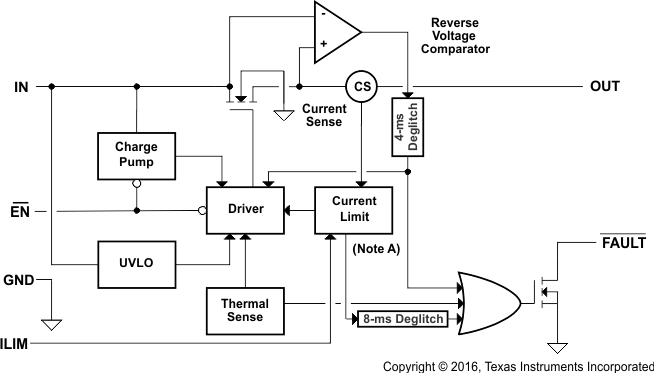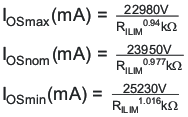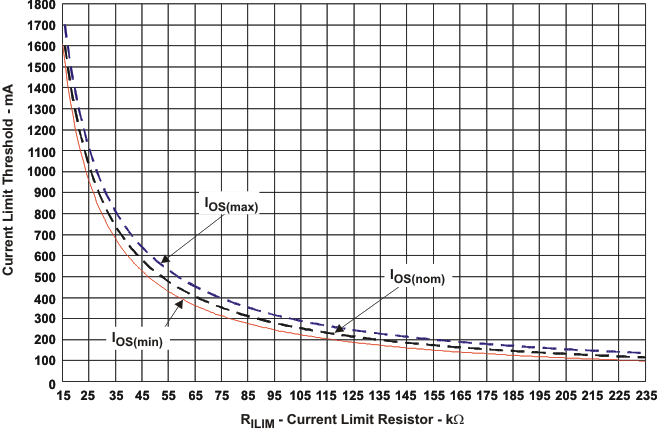SLVSDL7 September 2016 TPS2552D , TPS2553D
PRODUCTION DATA.
- 1 Features
- 2 Applications
- 3 Description
- 4 Revision History
- 5 Device Comparison Table
- 6 Pin Configuration and Functions
- 7 Specifications
- 8 Parameter Measurement Information
- 9 Detailed Description
- 10Application and Implementation
- 11Power Supply Recommendations
- 12Layout
- 13Device and Documentation Support
- 14Mechanical, Packaging, and Orderable Information
Package Options
Mechanical Data (Package|Pins)
- DBV|6
Thermal pad, mechanical data (Package|Pins)
Orderable Information
9 Detailed Description
9.1 Overview
The TPS2552D and TPS2553D are current-limited, power-distribution switches using N-channel MOSFETs for applications where short circuits or heavy capacitive loads will be encountered and provide up to 1.5 A of continuous load current. These devices allow the user to program the current-limit threshold between 75 mA and 1.7 A (typ) via an external resistor. Additional device shutdown features include overtemperature protection and reverse-voltage protection. The device incorporates an internal charge pump and gate drive circuitry necessary to drive the N-channel MOSFET. The charge pump supplies power to the driver circuit and provides the necessary voltage to pull the gate of the MOSFET above the source. The charge pump operates from input voltages as low as 2.7 V and requires little supply current. The driver controls the gate voltage of the power switch. The driver incorporates circuitry that controls the rise and fall times of the output voltage to limit large current and voltage surges and provides built-in soft-start functionality. There are two device families that handle overcurrent situations differently. The TPS255xD family enters constant-current mode when the load exceeds the current-limit threshold.
9.2 Functional Block Diagram

9.3 Feature Description
9.3.1 Overcurrent Conditions
The TPS2552D and TPS2553D respiond to overcurrent conditions by limiting their output current to the IOS levels shown in Figure 23. When an overcurrent condition is detected, the device maintains a constant output current and reduces the output voltage accordingly. Two possible overload conditions can occur.
The first condition is when a short circuit or partial short circuit is present when the device is powered-up or enabled. The output voltage is held near zero potential with respect to ground and the TPS2552D and TPS2553D ramps the output current to IOS. The TPS2552D and TPS2553D devices limits the current to IOS until the overload condition is removed or the device begins to thermal cycle.
The second condition is when a short circuit, partial short circuit, or transient overload occurs while the device is enabled and powered on. The device responds to the overcurrent condition within time tIOS (see Figure 21). The current-sense amplifier is overdriven during this time and momentarily disables the internal current-limit MOSFET. The current-sense amplifier recovers and limits the output current to IOS. Similar to the previous case, the TPS2552D and TPS2553D devices limit the current to IOS until the overload condition is removed or the device begins to thermal cycle.
The TPS2552D/53D thermal cycles if an overload condition is present long enough to activate thermal limiting in any of the above cases. The device turns off when the junction temperature exceeds 135°C (typ) while in current limit. The device remains off until the junction temperature cools 10°C (typ) and then restarts. The TPS2552D/53D cycle on/off until the overload is removed (see Figure 6 and Figure 8) .
9.3.2 Reverse-Voltage Protection
The reverse-voltage protection feature turns off the N-channel MOSFET whenever the output voltage exceeds the input voltage by 135 mV (typ) for 4-ms (typ).A reverse current of (VOUT – VIN)/rDS(on)) are present when this occurs. This prevents damage to devices on the input side of the TPS2552D/53D by preventing significant current from sinking into the input capacitance. The TPS2552D/53D devices allow the N-channel MOSFET to turn on once the output voltage goes below the input voltage for the same 4-ms deglitch time. The reverse-voltage comparator also asserts the FAULT output (active-low) after 4-ms.
9.3.3 FAULT Response
The FAULT open-drain output is asserted (active low) during an overcurrent, overtemperature or reverse-voltage condition. The TPS2552D/53D asserts the FAULT signal until the fault condition is removed and the device resumes normal operation. The TPS2552D/53D are designed to eliminate false FAULT reporting by using an internal delay "deglitch" circuit for overcurrent (7.5-ms typ) and reverse-voltage (4-ms typ) conditions without the need for external circuitry. This ensures that FAULT is not accidentally asserted due to normal operation such as starting into a heavy capacitive load. The deglitch circuitry delays entering and leaving fault conditions. Overtemperature conditions are not deglitched and assert the FAULT signal immediately.
9.3.4 Undervoltage Lockout (UVLO)
The undervoltage lockout (UVLO) circuit disables the power switch until the input voltage reaches the UVLO turn-on threshold. Built-in hysteresis prevents unwanted on/off cycling due to input voltage drop from large current surges.
9.3.5 ENABLE
The logic enable controls the power switch, bias for the charge pump, driver, and other circuits to reduce the supply current. The supply current is reduced to less than 1-μA when a logic high is present on EN or when a logic low is present on EN. A logic low input on EN or a logic high input on EN enables the driver,A logic high input on EN enables the driver, control circuits, and power switch. The enable input is compatible with both TTL and CMOS logic levels.
9.3.6 Thermal Sense
The TPS2552D/53D self-protection features use two independent thermal sensing circuits that monitor the operating temperature of the power switch and disable operation if the temperature exceeds recommended operating conditions. The TPS2552D/53D devices operate in constant-current mode during an overcurrent conditions, which increases the voltage drop across power-switch. The power dissipation in the package is proportional to the voltage drop across the power switch, which increases the junction temperature during an overcurrent condition. The first thermal sensor turns off the power switch when the die temperature exceeds 135°C (min) and the part is in current limit. Hysteresis is built into the thermal sensor, and the switch turns on after the device has cooled approximately 10°C.
The TPS2552D/3D also have a second ambient thermal sensor. The ambient thermal sensor turns off the power-switch when the die temperature exceeds 155°C (min) regardless of whether the power switch is in current limit and will turn on the power switch after the device has cooled approximately 10°C. The TPS2552D/53D families continue to cycle off and on until the fault is removed.
The open-drain fault reporting output FAULT is asserted (active low) immediately during an overtemperature shutdown condition.
9.4 Device Functional Modes
There are no other functional modes.
9.5 Programming
9.5.1 Programming the Current-Limit Threshold
The overcurrent threshold is user programmable via an external resistor. The TPS2552D/53D use an internal regulation loop to provide a regulated voltage on the ILIM pin. The current-limit threshold is proportional to the current sourced out of ILIM. The recommended 1% resistor range for RILIM is 15 kΩ ≤ RILIM ≤ 232 kΩ to ensure stability of the internal regulation loop. Many applications require that the minimum current limit is above a certain current level or that the maximum current limit is below a certain current level, so it is important to consider the tolerance of the overcurrent threshold when selecting a value for RILIM. The following equations and Figure 23 can be used to calculate the resulting overcurrent threshold for a given external resistor value (RILIM). Figure 23 includes current-limit tolerance due to variations caused by temperature and process. However, the equations do not account for tolerance due to external resistor variation, so it is important to account for this tolerance when selecting RILIM. The traces routing the RILIM resistor to the TPS2552D/53D should be as short as possible to reduce parasitic effects on the current-limit accuracy.
RILIM can be selected to provide a current-limit threshold that occurs 1) above a minimum load current or 2) below a maximum load current.
To design above a minimum current-limit threshold, find the intersection of RILIM and the maximum desired load current on the IOS(min) curve and choose a value of RILIM below this value. Programming the current limit above a minimum threshold is important to ensure start up into full load or heavy capacitive loads. The resulting maximum current-limit threshold is the intersection of the selected value of RILIM and the IOS(max) curve.
To design below a maximum current-limit threshold, find the intersection of RILIM and the maximum desired load current on the IOS(max) curve and choose a value of RILIM above this value. Programming the current limit below a maximum threshold is important to avoid current limiting upstream power supplies causing the input voltage bus to droop. The resulting minimum current-limit threshold is the intersection of the selected value of RILIM and the IOS(min) curve.
Current-Limit Threshold Equations (IOS):

where 15 kΩ ≤ RILIM ≤ 232 kΩ.
While the maximum recommended value of RILIM is 232 kΩ, there is one additional configuration that allows for a lower current-limit threshold. The ILIM pin may be connected directly to IN to provide a 75 mA (typ) current-limit threshold. Additional low-ESR ceramic capacitance may be necessary from IN to GND in this configuration to prevent unwanted noise from coupling into the sensitive ILIM circuitry.
 Figure 23. Current-Limit Threshold vs RILIM
Figure 23. Current-Limit Threshold vs RILIM